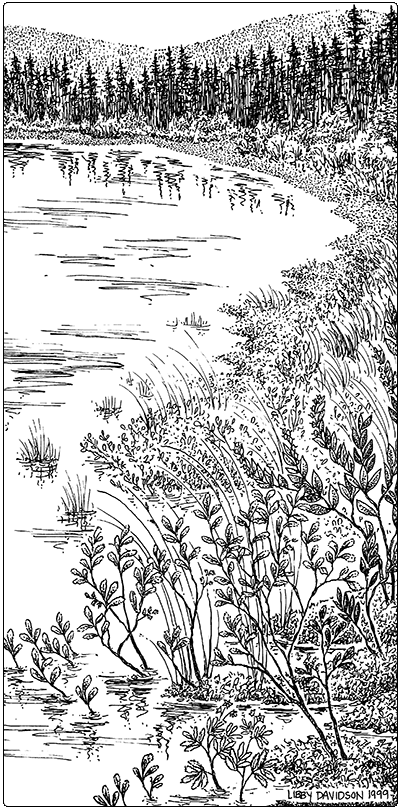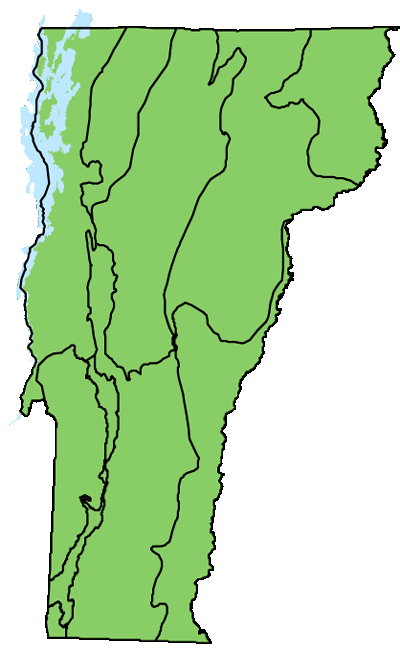Ecology and Physical Setting 
Sweet Gale Shoreline Swamps are found along the peaty shores of small ponds and along the edges of slowly moving streams. The roots of sweet gale and other species create a floating mat that extends over the pond or stream waters. A pioneering community, Sweet Gale Shoreline Swamp is frequently a narrow zone between open water and other community types. Landward, it might grade into other peatlands or forested wetlands, or even upland forests. The substrate is a floating sedgy peat, supported and held together by the network of shrub roots and sedge rhizomes. Near the water’s edge, this fibrous mat may not be strong enough to support a person, but further back from the open water the peat is more likely to be grounded and safe for tentative, exploratory steps. This community is probably best viewed from a canoe.
Sweet gale has spongy, floating fruits that disperse well in water. It also has the ability to fix nitrogen in the soil. These adaptations contribute to its success on pond margins. Sweet gale also seems to thrive in a wide range of soil conditions, from acidic to calcium-rich. In soft-water (acidic) ponds, even low concentrations of dissolved minerals provide an undepletable supply for those plants whose roots are in contact with the water.
Vegetation
This shrub swamp community is dominated by sweet gale, but meadowsweet and leatherleaf may also be common. In more mineral-rich shoreline habitats, stunted northern white cedar saplings may be present. Red maple saplings and speckled alder are common in low abundance.
Sedges are abundant, especially woolly-fruited sedge and tussock sedge. Other common herbs include bluejoint grass, marsh cinquefoil, swamp candles, and marsh St. John’s-wort. Common bryophytes include Sphagnum teres, Sphagnum subsecundum, and Straminergon stramineum.
Wildlife Habitat
Sweet Gale Shoreline Swamps support several species of frogs that require open water for breeding and vegetation cover for protection. These frogs include gray treefrog, green frog, American bullfrog, and in northeastern Vermont, the uncommon mink frog. These swamps also provide breeding and nesting habitat for several birds, including common yellowthroat, northern waterthrush, swamp sparrow, and Wilson’s snipe. In more remote settings, especially in northeastern Vermont, Sweet Gale Shoreline Swamps provide nesting sites for common loons and American black ducks, as well as the very rare ring-necked duck—a duck that typically nests in the boreal north.
Like other peatlands associated with water, Sweet Gale Shoreline Swamps support several species of dragonflies. These include the common frosted whiteface, and in northeastern Vermont, the rare Kennedy’s emerald, ocellated emerald, and forcipate emerald.
Related Communities
- Intermediate Fen is dominated by woolly-fruited sedge and a rich bryophyte flora, and it is typically associated with calcareous groundwater seepage. It may also occur as a pioneering mat along pond shores. In these cases, Intermediate Fens are distinguished from Sweet Gale Shoreline Swamps by the lack of shrub dominance.
Conservation Status and Management Considerations
Human alteration of the hydrologic regime of associated ponds and streams is the primary threat to this community. Conservation work to protect examples of this community will need to focus on the ecological processes that maintain both the aquatic systems and the other wetlands occurring in the wetland complex. Some excellent examples of this community are protected on conserved lands.
Distribution/Abundance 
Sweet Gale Shoreline Swamps occur throughout Vermont. This community is found throughout New England, New York, and adjacent Canada.
Characteristic Plants
Shrubs and Stunted Trees
Abundant Species
Sweet gale – Myrica gale
Meadowsweet – Spiraea alba
Leatherleaf – Chamaedaphne calyculata
Occasional to Locally Abundant Species
Speckled alder – Alnus incana
Swamp rose – Rosa palustris
Red-osier dogwood – Cornus sericea
Willow – Salix spp.
Bog rosemary – Andromeda polifolia
Alder-leaved buckthorn – Rhamnus alnifolia
Red maple saplings – Acer rubrum
Northern white cedar – Thuja occidentalis
Tamarack – Larix laricina
Herbs
Abundant Species
Woolly-fruited sedge – Carex lasiocarpa
Tussock sedge – Carex stricta
Occasional to Locally Abundant Species
Bluejoint grass – Calamagrostis canadensis
Marsh cinquefoil – Comarum palustre
Swamp candles – Lysimachia terrestris
Marsh St. John’s-wort – Triadenum fraseri
Common cattail – Typha latifolia
Three-way sedge – Dulichium arundinaceum
Northern bugleweed – Lycopus uniflorus
Blue flag – Iris versicolor
Royal fern – Osmunda regalis
Bryophytes
Occasional to Locally Abundant Species
Moss – Sphagnum teres
Moss – Sphagnum subsecundum
Moss – Straminergon stramineum
Rare and Uncommon Plants
Creeping sedge – Carex chordorrhiza
Marsh mermaid-weed – Proserpinaca palustris
American reed – Phragmites australis ssp. americana
Shining rose – Rosa nitida
Satiny willow – Salix pellita
Bog willow – Salix pedicellaris
Associated Animals
Gray treefrog – Hyla versicolor
Green frog – Lithobates clamitans
American bullfrog – Lithobates catesbeianus
Common yellowthroat – Geothlypis trichas
Northern waterthrush – Parkesia noveboracensis
Wilson’s snipe – Gallinago delicata
Red-winged blackbird – Agelaius phoeniceus
Swamp sparrow – Melospiza georgiana
Frosted whiteface – Leucorrhinia frigida
Macropis bee – Macropis nuda
Rare and Uncommon Animals
Mink frog – Lithobates septentrionalis
Common loon – Gavia immer
Ring-necked duck – Aythya collaris
American black duck – Anas rubripes
Kennedy’s emerald – Somatochlora kennedyi
Ocellated emerald – Somatochlora minor
Forcipate emerald – Somatochlora forcipata
Places to Visit
South Bay Wildlife Management Area, Coventry and Newport, Vermont Fish and Wildlife Department (VFWD)
Clyde River wetlands, Charleston and Brighton (best viewed from the river)
Island Pond Bog, Brighton, Brighton State Park, Vermont Department of Forests, Parks, and Recreation
Tinmouth Channel Wildlife Management Area, Tinmouth, VFWD
